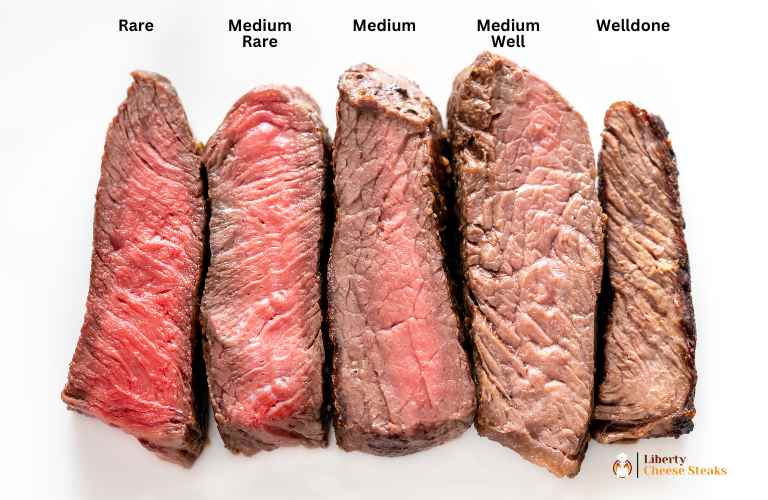When it comes to enjoying a perfectly cooked steak, understanding the concept of steak doneness levels is essential.
The level of doneness determines the internal temperature and, consequently, the texture, juiciness, and flavor of the steak.
Whether you prefer a tender and juicy rare steak or a well-done steak with a rich crust, knowing the different doneness levels and how to achieve them will elevate your steak-cooking skills to the next level.
In this comprehensive guide, we will explore the various steak doneness levels, from rare to well done, and provide you with detailed explanations, recommended cooking times and temperatures, as well as useful tips to achieve the desired level of doneness.
I. Rare
Rare steak is cooked quickly at high heat, leaving the center of the steak cool and red. It is characterized by its exceptionally juicy and tender texture.
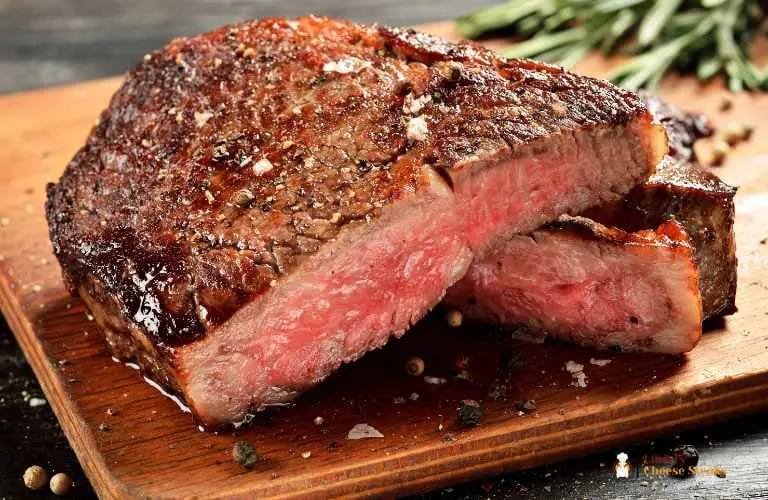
Description and characteristics of rare steak
Rare steak has a bright red, cool center, with a slightly seared crust on the outside. It is soft and tender to the touch, with a juicy and moist interior.
Recommended cooking time and temperature
To achieve a rare doneness, it is recommended to cook the steak for a short duration at a high heat.
The internal temperature should reach around 125°F (52°C). This can be achieved by searing the steak for 2-3 minutes per side on a hot grill or pan.
Tips for achieving a perfectly rare steak
- Start with a good quality, fresh steak.
- Allow the steak to reach room temperature before cooking.
- Pat the steak dry and season it with salt and pepper.
- Preheat the grill or pan to high heat.
- Sear the steak for 2-3 minutes on each side.
- Use a meat thermometer to ensure the internal temperature reaches 125°F (52°C).
- Let the steak rest for a few minutes before slicing to retain its juices.
Popular cuts of steak suitable for rare doneness
Some popular cuts that work well for rare steak include:
- Filet mignon
- Ribeye
- New York strip
II. Medium Rare
Medium rare is one of the most popular steak doneness levels. It offers a perfect balance between tenderness, juiciness, and a slight pink center.
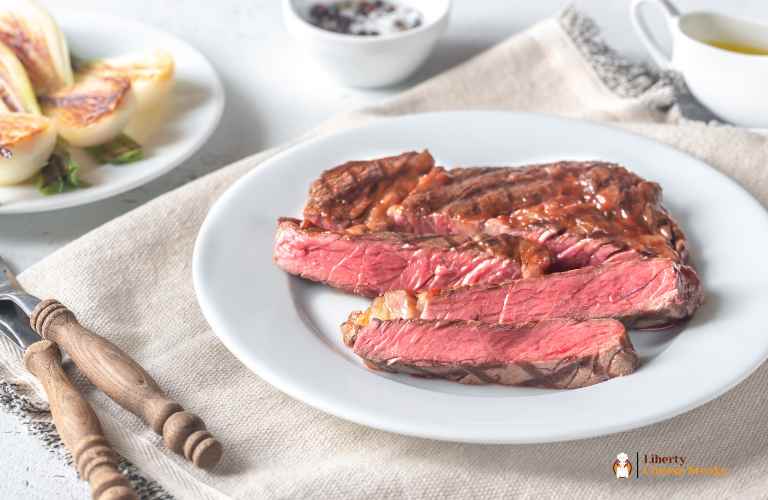
Description and characteristics of medium rare steak
Medium rare steak has a warm red center with a hint of pink. It retains a juicy and tender texture while developing a flavorful seared crust on the outside.
Recommended cooking time and temperature
To achieve a medium rare doneness, cook the steak until the internal temperature reaches around 135°F (57°C).
This typically requires searing the steak for about 3-4 minutes per side and allowing it to rest.
Tips for achieving a perfectly medium rare steak
- Follow the same tips as for rare steak regarding the quality of the meat, room temperature, seasoning, and preheating.
- Sear the steak for 3-4 minutes per side to achieve the desired crust.
- Use a meat thermometer to ensure the internal temperature reaches 135°F (57°C).
- Let the steak rest for a few minutes to allow the juices to redistribute before serving.
Popular cuts of steak suitable for medium rare doneness
Some popular cuts that are often cooked to medium rare include:
- Sirloin
- T-Bone
- Porterhouse
III. Medium
Medium steak is cooked to a higher internal temperature, resulting in a more pronounced pink center and a slightly firmer texture.
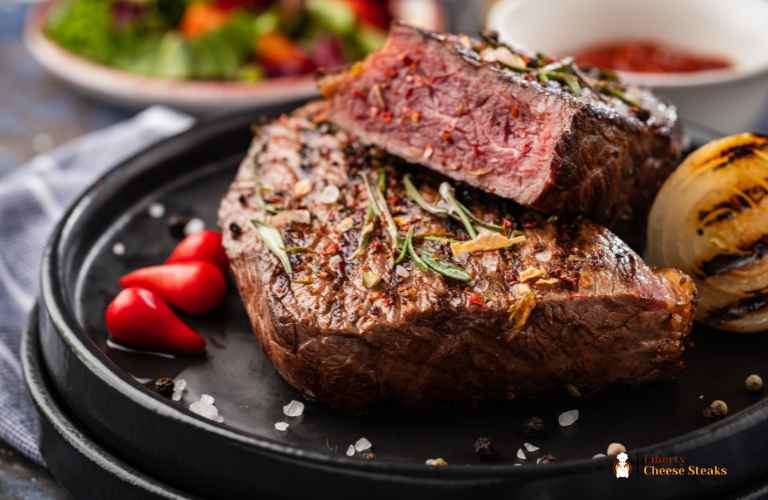
Description and characteristics of medium steak
Medium steak has a warm pink center with a slightly firm texture. It retains a good amount of juiciness while offering a more substantial mouthfeel compared to rare and medium rare steaks.
Recommended cooking time and temperature
To achieve a medium doneness, cook the steak until the internal temperature reaches around 145°F (63°C). This usually requires searing the steak for about 4-5 minutes per side and allowing it to rest.
Tips for achieving a perfectly medium steak
- Apply the same guidelines as for rare and medium rare steak regarding meat quality, room temperature, seasoning, and preheating.
- Sear the steak for 4-5 minutes per side to develop a flavorful crust.
- Use a meat thermometer to ensure the internal temperature reaches 145°F (63°C).
- Let the steak rest for a few minutes to allow the juices to redistribute before serving.
Popular cuts of steak suitable for medium doneness
Some popular cuts that are often cooked to medium include:
- Top sirloin
- Flank steak
- Skirt steak
IV. Medium Well
Medium well steak is cooked to a higher internal temperature, resulting in a smaller pink center and a firmer texture.
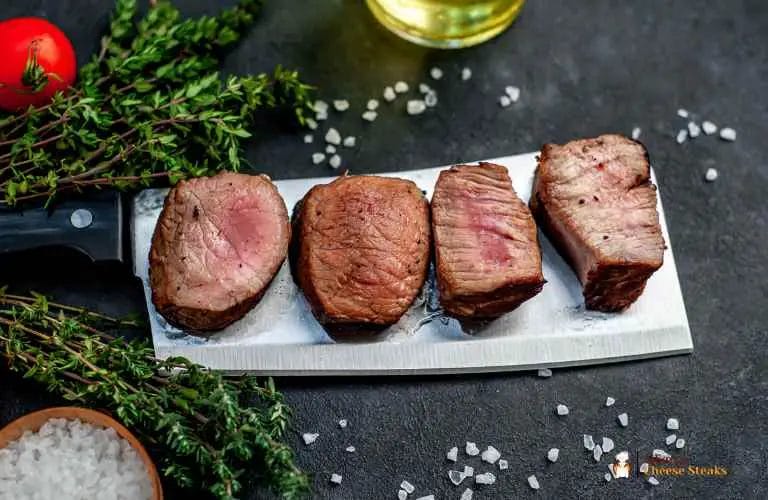
Description and characteristics of medium well steak
Medium well steak has a slightly pink center with minimal juices. It offers a firmer texture and a more well-done appearance compared to medium steak.
Recommended cooking time and temperature
To achieve a medium well doneness, cook the steak until the internal temperature reaches around 155°F (68°C).
This typically requires searing the steak for about 5-6 minutes per side and allowing it to rest.
Tips for achieving a perfectly medium well steak
- Apply the same guidelines as for rare, medium rare, and medium steak regarding meat quality, room temperature, seasoning, and preheating.
- Sear the steak for 5-6 minutes per side to develop a flavorful crust.
- Use a meat thermometer to ensure the internal temperature reaches 155°F (68°C).
- Let the steak rest for a few minutes to allow the juices to redistribute before serving.
Popular cuts of steak suitable for medium well doneness
Some popular cuts that work well for medium well steak include:
- Round steak
- Eye of round
- Bottom sirloin
V. Well Done
Well-done steak is cooked thoroughly, resulting in no pink color and a firm texture throughout.
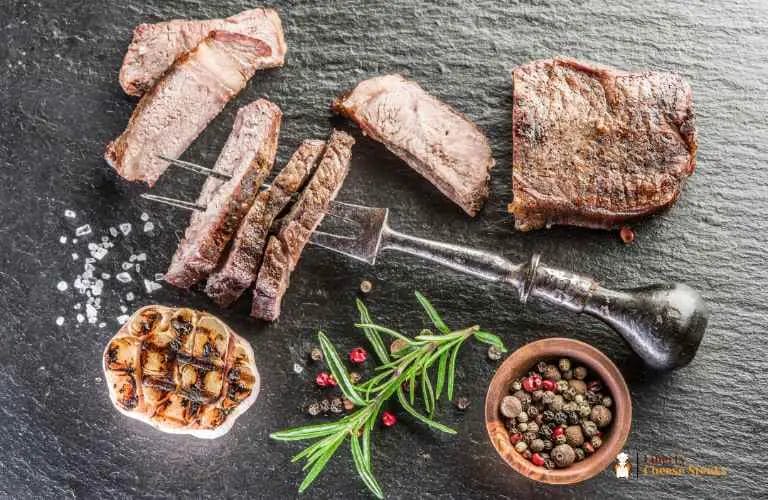
Description and characteristics of well-done steak
Well-done steak is uniformly brown with no trace of pink. It offers a firm and dry texture, with minimal juices.
Recommended cooking time and temperature
To achieve a well-done doneness, cook the steak until the internal temperature reaches around 160°F (71°C) or higher.
This usually requires searing the steak for about 6-7 minutes per side and allowing it to rest.
Tips for achieving a perfectly well-done steak
- Follow the same guidelines as for the previous doneness levels regarding meat quality, room temperature, seasoning, and preheating.
- Sear the steak for 6-7 minutes per side to develop a substantial crust.
- Use a meat thermometer to ensure the internal temperature reaches 160°F (71°C) or higher.
- Let the steak rest for a few minutes to allow the juices to redistribute before serving.
Popular cuts of steak suitable for well-done doneness
Well-done steak can be achieved with various cuts, including:
- Chuck steak
- Rump steak
- Cube steak
VI. Factors influencing steak doneness
Several factors can influence the doneness level of a steak, and it’s important to consider them when cooking:
Thickness of the steak
Thicker steaks will require more cooking time to reach the desired doneness compared to thinner cuts. Adjust the cooking time accordingly to ensure even cooking.
Type of heat source
Different heat sources, such as gas grills, charcoal grills, or stovetop pans, may vary in temperature output. Adjust the cooking time and temperature based on the specific heat source you are using.
Resting time after cooking
Allowing the steak to rest for a few minutes after cooking helps retain its juices and ensures more even distribution of heat.
This resting period also allows the internal temperature to continue rising slightly.
The use of a meat thermometer
Using a meat thermometer is the most accurate way to determine the internal temperature of the steak and achieve the desired doneness.
Insert the thermometer into the thickest part of the steak without touching the bone for an accurate reading.
VII. Personal preferences and cultural variations
Personal preferences for steak doneness can vary widely. Additionally, cultural variations influence the preferred doneness levels in different regions.
Some cultures prefer their steaks more well-done, while others prefer a rarer doneness. When cooking for others, it’s important to consider their preferences and adjust accordingly.
Conclusion
Understanding steak doneness levels is crucial for achieving the perfect steak every time. Whether you prefer a rare, medium, medium well, or well-done steak, the key lies in choosing the right cooking time and temperature, using a meat thermometer for accuracy, and allowing the steak to rest before serving.
Experiment with different cuts and doneness levels to find your personal favorite, and don’t forget to consider cultural preferences when cooking for others.
With these insights and tips, you’re ready to elevate your steak-cooking skills and impress your family and friends with perfectly cooked steaks. Happy grilling!
Frequently Asked Questions (FAQs)
Can I change the doneness level of a cooked steak?
Once a steak is cooked to a certain doneness level, it is challenging to change it. It’s best to cook the steak to the desired doneness from the beginning.
Can I use a meat thermometer to determine doneness?
Yes, a meat thermometer is an excellent tool to determine the internal temperature of the steak and, consequently, its doneness level.
Make sure to insert the thermometer into the thickest part of the steak for an accurate reading.
How can I fix an overcooked or undercooked steak?
If you’ve accidentally overcooked a steak, consider adding sauces or toppings to enhance its flavor and moisture.
For an undercooked steak, you can return it to the grill or pan briefly to achieve the desired doneness, but be careful not to overcook it further.
How do I determine the doneness of a steak without a meat thermometer?
While using a meat thermometer is the most accurate method, you can assess the doneness of a steak by touch.
The touch method involves comparing the firmness of the meat to different parts of your hand (e.g., thumb to pinky for rare, thumb to ring finger for medium rare, and so on).
However, keep in mind that this method requires practice and experience to be reliable.
What if I prefer a steak doneness level that is not mentioned in the guide?
The doneness levels mentioned in the guide are the most commonly recognized ones. However, individual preferences can vary.
If you prefer a doneness level that falls between two mentioned levels, you can adjust the cooking time and temperature accordingly. It’s important to experiment and find the cooking method that suits your personal taste.
Can I achieve a rare or medium rare doneness with a well-done cut of steak?
It can be challenging to achieve a rare or medium rare doneness with cuts of steak that are traditionally better suited for well-done preparations.
Well-done cuts, such as chuck steak or cube steak, are typically tougher and require longer cooking times to become tender.
If you prefer a rare or medium rare doneness, it’s recommended to choose cuts that are naturally tender and suited for those levels.
Is it possible to have a steak that is both well-done and still juicy?
Achieving a well-done steak that is still juicy can be challenging, as the longer cooking time required for well-done doneness tends to reduce the juiciness.
However, marinating the steak before cooking, basting it with butter or oil during cooking, or using cuts with higher fat content can help retain some moisture and enhance juiciness even in well-done steaks.
Can I achieve different doneness levels on different parts of the same steak?
It is possible to achieve different doneness levels on different parts of the same steak, especially if the steak has irregular thickness or varying levels of marbling.
This can be accomplished by using different cooking techniques or adjusting cooking times for different sections of the steak.
However, it requires careful monitoring and attention to ensure each section reaches the desired doneness level.
Can I use a grill or a pan to achieve the same doneness levels?
Both grilling and pan-searing methods can be used to achieve the desired doneness levels. However, grilling tends to provide a slightly different flavor profile and can result in more pronounced grill marks and smokiness.
Pan-searing, on the other hand, can create a flavorful crust and allow for greater control over the cooking process.
Ultimately, the choice between grill and pan depends on personal preference and the equipment available.
Why is it important to let the steak rest before serving?
Allowing the steak to rest for a few minutes after cooking is important for several reasons. Resting allows the juices to redistribute throughout the meat, ensuring a more flavorful and moist steak.
It also helps the steak retain its internal temperature and prevents the juices from seeping out when sliced.
Resting the steak for 5-10 minutes allows for better texture and overall improved dining experience.
Can I achieve the same doneness levels with different cooking methods, such as sous vide or reverse searing?
Yes, alternative cooking methods like sous vide or reverse searing can be used to achieve the desired doneness levels.
Sous vide involves cooking the steak in a precisely controlled water bath, which allows for precise temperature control and even cooking.
Reverse searing involves slowly cooking the steak at a low temperature first and then finishing it with a high-heat sear.
Both methods can result in delicious steaks with the desired doneness level, but they require specialized equipment and techniques.
What if I prefer my steak to be well done, but I’m concerned about it being tough?
Well-done steaks are often associated with a drier and tougher texture due to the prolonged cooking time.
To help mitigate potential toughness, consider marinating the steak before cooking to add flavor and tenderness.
Additionally, using cuts with higher fat content, such as ribeye or strip steak, can contribute to a more tender and juicy well-done steak.
Is it safe to eat rare or medium rare steak?
Steak can be safely consumed at rare or medium rare doneness if it is sourced from a reputable supplier and handled properly.
However, for individuals with compromised immune systems or other health conditions, it’s advisable to cook steak to a higher doneness level to minimize the risk of foodborne illnesses.
Are there any specific safety guidelines when cooking steaks to rare or medium-rare doneness?
When cooking steaks to rare or medium-rare doneness, it’s important to ensure food safety. Use fresh, high-quality steaks from reliable sources to minimize the risk of foodborne illnesses.
It’s recommended to sear the exterior of the steak at high heat to kill surface bacteria.
If you have concerns about the safety of consuming rare or medium-rare steak, you can choose to use a meat thermometer to ensure the internal temperature reaches the recommended safe levels (145°F/63°C for medium-rare).

